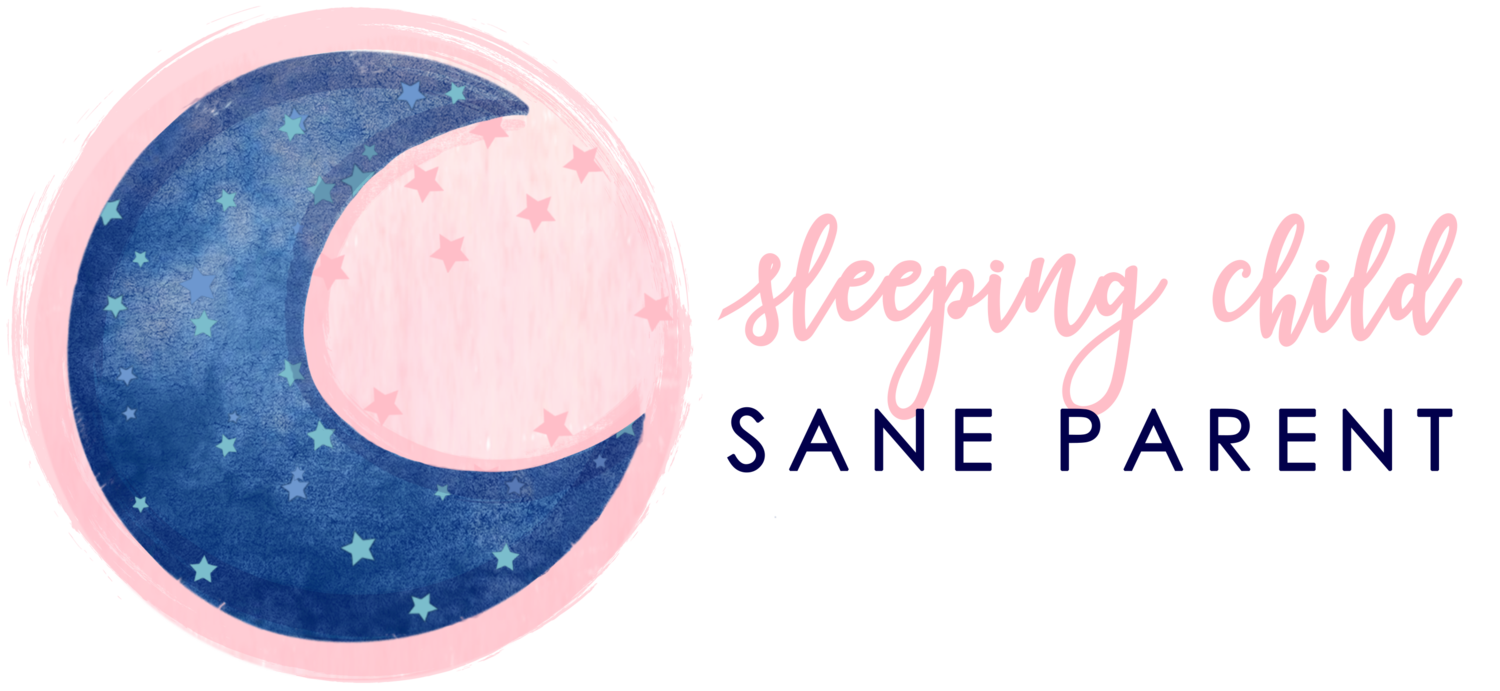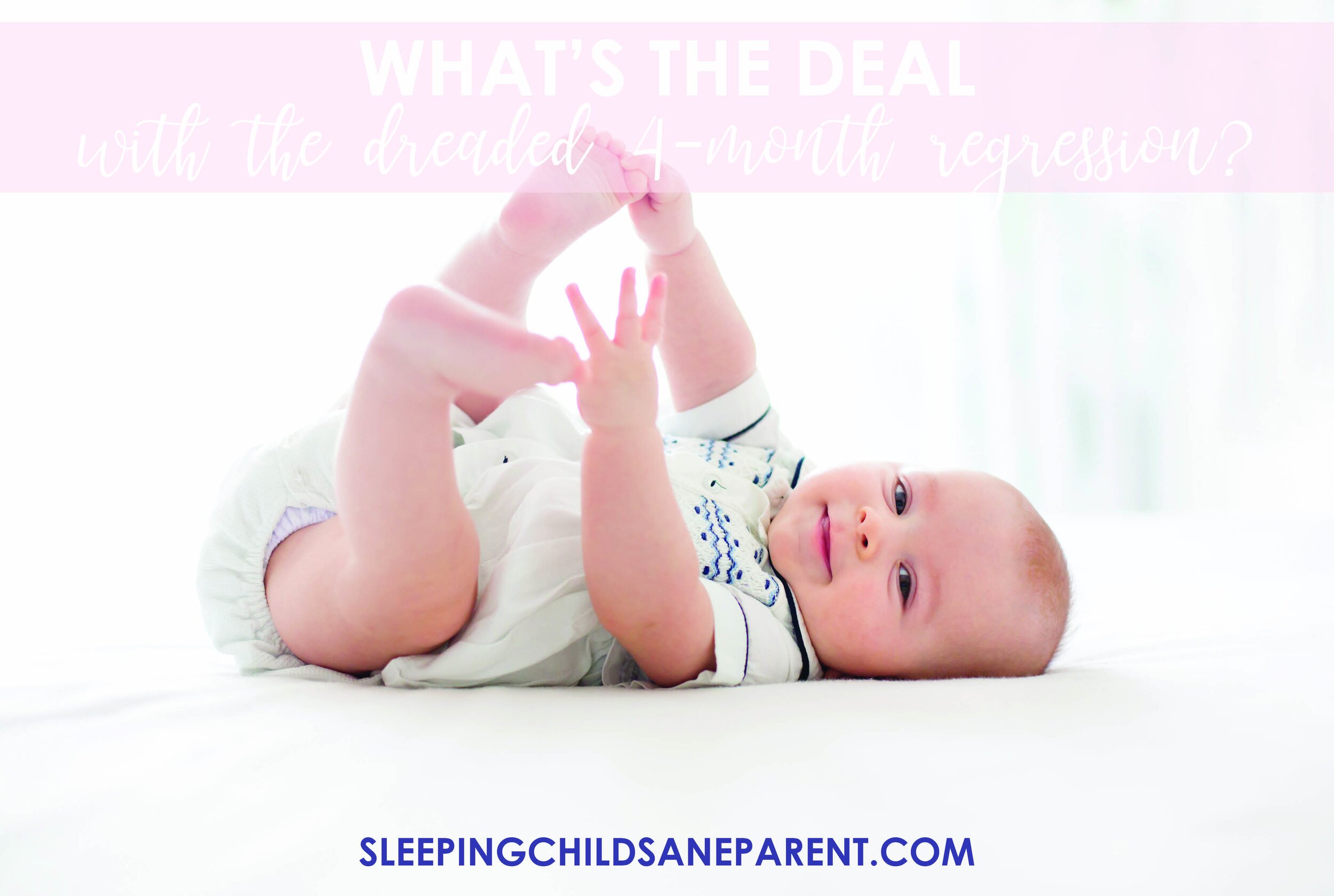I get questions all the time about various sleep regressions, so I decided it’s time to explain them all in a blog mini-series! But first off . . .
What is a Sleep Regression?
When Baby was sleeping well, and now she’s not, she might be going through a sleep regression!
Some regressions are a result of outside factors, and are typically short-lived, unless parents get over-involved. These minor regressions might be caused by teething, moving, or getting a new sibling, to name a few. Click for more information about what to do about these types of regressions.
Other regressions are a result of internal factors, like developmental milestones and/or changing sleep needs. Those are the ones we’ll be discussing in this mini-series.
When does the 4-month regression occur?
All regressions have a number in them, but the regression actually has a little more wiggle room than that.
The 4-month regression typically happens sometime between 3 and 5 months. If your baby was born early, the regression will likely come later — more like 4 months from the due date. If your baby was born late, the regression may come earlier.
Or, because babies aren’t robots, it may not matter when your baby was born — so look out for this regression anytime between the designated 3 and 5 months.
What does the 4-month regression look like?
The 4-month regression is typically characterized by frequent nightwakings and/or short naps, when Baby was previously sleeping longer stretches in both day and night.
That’s why, when I hear people say that their newborn is an amazing sleeper, I almost hold my breath for them <insert *eek* emoji> …because how your newborn sleeps doesn’t necessarily predict how they’ll sleep after they’re 4 months old! Which actually isn’t all bad news, because that’s also true if they’ve been a horrible sleeper up to 4 months!
What causes the 4-month Regression?
Regression almost always means progression in some way. In the case of the 4-month regression, Baby’s sleep is developing to become more like adult sleep — divided into cycles of REM and non-REM, and having partial arousals between the cycles.
During these arousals, adults might change position, quickly (and mostly unconsciously) check surroundings for safety, or even realize they need to go to the bathroom. After taking said actions, they’ll return to sleep quickly and easily, likely not even remembering the more brief arousals.
However, in the case of your 4-month-old, the partial arousals are actually full wake-ups that disrupt everybody’s sleep!
But what does that really mean?
When Baby begins waking between sleep cycles, she’ll notice any differences between how things were when she fell asleep vs. how things are now. So if she fell asleep nursing, bouncing, or cuddling with mom, and now wakes up alone in her crib, she won’t just turn her head and return to sleep — she’ll want those familiar cues to be replaced in order to return to sleep. AKA, “Get back here and feed me again, Mom!” Which is why the feeding calls have suddenly increased.
Think of it this way — if you went to bed in your bed, with your pillow and your sheets, next to your spouse, but woke up on your living room floor, you wouldn’t just shrug it off and go back to sleep. You’d immediately become fully alert, trying to figure out what happened — did you drink too much? pass out? what happened??
That’s exactly what happens with your baby — “Where is my mom?! I’m not safe without her, nor can I sleep without her help!”
So what can you do?
How to Get Good Sleep Again
If you’re hoping your little one will simply “grow out of” the 4-month regression, I’m here to let you know that’s not how it works. Sure, some kids might improve somewhat over the next few months without you doing anything, but if you really want restorative, unbroken sleep for your child and for you, you’ll have to help them learn the important sleep skill of falling asleep independently.
Luckily, this is a skill that can be taught quickly (1-2 weeks) and immediately! No need to just “tough it out” until things get better.
Step by Step
First off, if you’re reading this while your child is still a newborn, grab my Newborn Dream Key! My Newborn Dream Key teaches all about establishing a firm sleep foundation, which can help you get better sleep now and make the 4-month regression less bumpy! I honestly didn’t experience much change (if any!) at the 4-month mark with either of my girls because of the sleep foundation I laid for them in the beginning.
Next, start laying Baby down when she’s still awake. “Drowsy but awake” is for newborns; once Baby is 4 months we want her fully awake so she can do all the work of getting to sleep on her own. If you’re worried about your baby fighting you on this, I’ve got you! All of my Dream Keys — for ages 4 months to 5 years — teach you how to teach your child to fall asleep independently.
You should also give Baby at least a few minutes to work things out when she wakes in the night. The more she practices returning to sleep on her own, the better she’ll get at it! And as a reminder, if done with all the proper parameters (which are covered in detail in my Dream Keys), Baby should learn this skill within just a week or two!
Finally, make sure Baby is getting full feeds in throughout the day so that she doesn’t need to look for additional feeds at night. That means feeds every 2.5-4 hours throughout the day, because she only needs 0-2 feeds at night by 4 months.
Let’s bust through that 4-month regression together! Get more info on Dream Keys and one-on-one consultations here.


